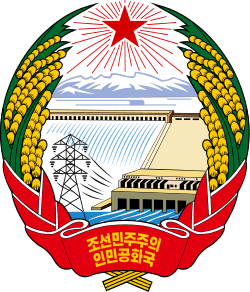Constitution of North Korea
| Wikisource has original text related to this article: |
| Wikisource has original text related to this article: |
| Korean Wikisource has original text related to this article: |
Democratic People's Republic of Korea
|
|---|
 |
| This article is part of a series on the politics and government of North Korea |
|
|
| Foreign relations |
|
Related topics |
|
Politics portal |
The Socialist Constitution of the Democratic People's Republic of Korea is the constitution of the Democratic People's Republic of Korea (DPRK), commonly known as North Korea. It lays out the framework of the national government and the functions of the ruling state party, the Workers' Party of Korea in relation to the Cabinet and Parliament. The constitution is divided into 166 articles, split between three sections.
History
Previous constitutions were adopted in 1948,[1] 1972,[2] 1992,[3] and 1998.[4] The constitution currently in force dates from 2012.
1948 Stalin constitution
The original North Korean constitution was devised by the Soviet Union. Joseph Stalin personally edited the constitution alongside Terentii Shtykov, de facto Soviet governor of North Korea, in Moscow. Some articles were later rewritten by Soviet supervisors.[5]
1972 revision
Proposing a DPRK new constitution had been discussed as early as 1960. However, in the changing international environment made North Korea could no longer postpone a constitutional revision.[6] This can be seen in Kim Il-sung’s speech at the first session of the fifth Supreme People's Assembly on December 25, 1972:
"…our realities today urgently demand the establishment of a new socialist constitution legally to consolidate the great achievements of our people in the socialist revolution and building of socialism and lay down principles for the political, economic, and cultural spheres in socialist society"
Under the new constitution, Kim Il-sung became the President of the DPRK. He became the head of state serving as commander of the armed forces and chairman of the National Defense Committee, he had the power to issue edicts, grant pardons, and conclude or abrogate treaties. Under the old constitution, there was no one designated as the head of state. The chairman of the Presidium of the Supreme People’s Assembly represented the state which followed the Soviet practice.
2009 and 2012 revisions
The new, amended in 2009 version of DPRK Constitution is six articles longer than the previous version adopted in of 1998. Section 2 of Chapter VI “Chairman of the National Defence Commission” is entirely new and the said post was constitutionally declared to be the supreme leader of North Korea. In Articles 29 and 40 (Economy and Culture respectively) the word 공산주의 (“communism”) was dropped.[7]
The Constitution was again amended in 2012 during the 5th Session of the 12th Supreme People's Assembly (SPA) to include changes in the preamble that states the legacy of Kim Jong-il in nation building and North Korea being a "nuclear-armed state",[8] Section 2 of Chapter VI, and several articles and provisions were revised accordingly due to provisions of Articles 91 and 95 that provide for constitutional amendments that are to be done by the SPA in its plenary sessions.
Overview
The constitution establishes North Korea's official name and its status as a socialist state.[9] Article 12 defines the country as a "dictatorship of people's democracy" (a wording that closely follows the Chinese model of the people's democratic dictatorship) under the leadership of the Workers' Party. It provides for civil and political rights, such as freedom of expression, the right to elect officials, the right to a fair trial, and freedom of religion. It asserts the right of every citizen to work, education, food, and healthcare.
In practice, however, these rights are limited by Article 81, which requires that all citizens "firmly safeguard the political and ideological unity and solidarity of the people," and Article 82, which requires that citizens observe "the socialist standards of life."
See also
Ten Principles for the Establishment of a Monolithic Ideological System
References
- ↑ Kim, Hyung-chan; Kim, Tong-gyu (2005). Human remolding in North Korea: a social history of education. University Press of America. p. 134.
- ↑ Constitution of North Korea (1972). Wikisource.
- ↑ Hale, Christopher (2002). 'North Korea in Evolution: The Correlation Between the Legal Framework and the Changing Dynamic of Politics and the Economy.' Korea Observer, Vol. 33 No. 3
- ↑ North Korea drops Communism from its Constitution. Azerbaijan Press Agency. September 28, 2009.
- ↑ "Terenti Shtykov: the other ruler of nascent North Korea" by Andrei Lankov. "...even the North Korean constitution was edited by Stalin himself and became law of the land only after a lengthy discussion in Moscow, where Shytkov and Stalin sat together looking through the draft of the country’s future supreme law. They approved it, but not completely, since some articles were rewritten by Soviet supervisors. So Shytkov, together with Stalin himself, can be seen as the authors of the North Korean constitution." Korea Times
- ↑ “Korea Today”. Foreign Languages Pub. House, (196), 1987. p. 3.
- ↑ DPRK has quietly amended its Constitution | Leonid Petrov's KOREA VISION. Leonidpetrov.wordpress.com (2009-10-12). Retrieved on 2013-07-12.
- ↑ North Korea proclaims itself a nuclear state in new constitution - CNN.com. Articles.cnn.com. Retrieved on 2013-07-12.
- ↑ Scalapino, Robert A.; Kim, Chun-yŏp (1983). North Korea today: strategic and domestic issues. Institute of East Asian Studies, University of California, Berkeley, Center for Korean Studies. p. 24.
External links
- Current text of the Constitution (April 2009) in English
- Text of the Constitution from "Naenara" (DPRK based site) in English
| ||||||||||||||